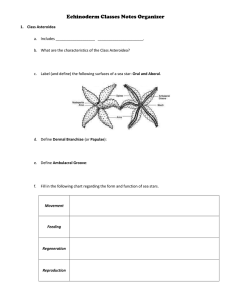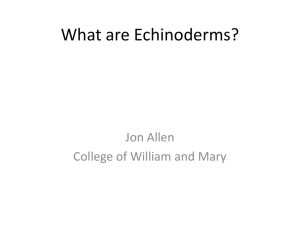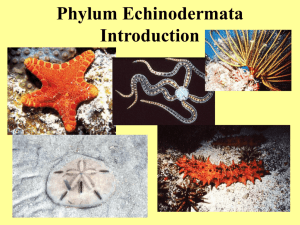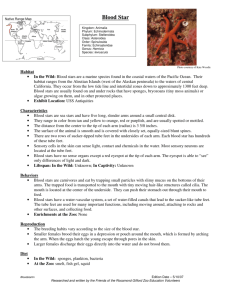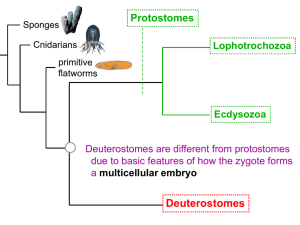4 Deuterostome phyla*
advertisement
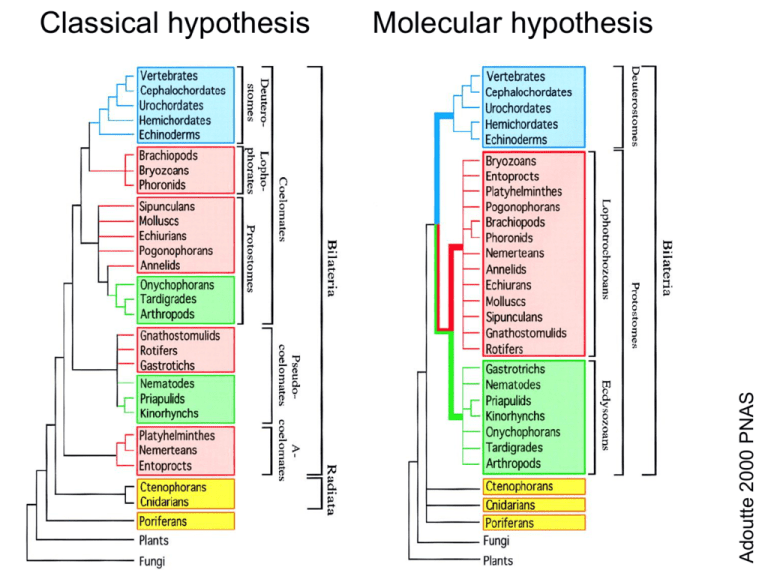
Molecular hypothesis Adoutte 2000 PNAS Classical hypothesis Protostome: Embryonic blastopore becomes mouth Schizocoelous development (typical of the protostome coelomates) Deuterostome: Embryonic blastopore becomes anus. Mouth forms as secondary opening Enterocoelous development (typical of the deuterostome coelomates) Cleavage Spiral- third division and subsequent are unequal…typical of protostomes Radial- third division is equal…typical of deuterostomes 4 Deuterostome phyla* • Echinodermata (sea stars, urchins, crinoids, et al.) • Hemichordata (acorn worms, pterobranchs, extinct graptolites) • Urochordata (tunicates, salps) • Chordata (cephalochordates, vertebrates) * Some authors place urochordates in Chordata Phylum Echinodermata ~7,000 extant species in five well-defined clades, ~13,000 extinct species and ~15 more classes. • Asteroidea (starfishes) • Ophiuroidea (basket stars and brittle stars), • Echinoidea (sea urchins, sand dollars, sea biscuits) • Holothuroidea (sea cucumbers). • Crinoidea (sea lilies and feather stars), • Concentricycloidea (sea daisies; 2 species), Synapomorphies of Echinoderms 1. Calcite skeleton composed of ossicles. 2. Water vascular system. 3. Mutable collagenous tissue. 4. Pentaradial body organization in adults. Also exclusively marine, coelomate, and deuterostome Echinoderm water vascular system Class Asteroidea (sea stars) • Mainly carnivorous – evert stomach to carry out digestion without ingestion. • Locomotion mainly by tube feet- arms move only slowly • Arms are short and thick, with coelomic extensions containing digestive glands and gonads Class Asteroidea (sea stars) Class Asteroidea (sea stars) Asteroidea, cont. • Respiratory gas exchange via ciliated dermal papillae and coelomic fluid. • Haemal (“blood”) system – function not understood. • Capable of extensive regeneration and asexual reproduction in some classes Class Asteroidea (sea stars) A seastar (Asterias) opening a bivalve Class Ophiuroidea (brittle stars) • Most diverse class of echinoderms~2,000 species. • Distinct central disc containing the organ systems. • Five highly flexible arms, capable of rapid movement by muscle action • No anus. Deposit, detritus, and suspension feeders. Class Ophiuroidea (brittle stars) Class Echinoidea (sea urchins, et al.) • Globular or flattened echinoderms without arms • Complex 5-part jaw apparatus (“Aristotle’s Lantern”) • Mainly grazers on algae, a few feed on bryozoans or sponges. • Some species harvested as food (the roe is eaten) Aristotle’s Lantern – 50 ossicles Class Holothuroidea (sea cucumbers) • Endoskeleton reduced • Elongated, flexible body propelled by 3 of the 5 rows tube feet • Tube feet around mouth are enlarged and branched to form feeding tentacles that gather food and transfer to mouth. • Gut has branches for respiration, and Cuvierian threads for defense. Class Holothuroidea (sea cucumbers) Class Holothuroidea sea cucumbers Class Holothuroidea (sea cucumbers) Class Crinoidea (crinoids) • exaggerated, branched arms used for suspension feeding, oral side up • Globular body (calyx) partially encased in skeletal plates • Feather stars (unstalked) and sea lilies (stalked, attached). • Greatest diversity in Paleozoic, with secondary radiation in Mesozoic after near-extinction Class Crinoidea (crinoids) Cyclonema on Glyptocrinus Commensal snail that fed on crinoid feces Crinoid calyces from the Burlington limestone M. C. Barnhart M. C. Barnhart M. C. Barnhart M. C. Barnhart Echinoderm diversity thru time There are at least 15 described extinct classes of Echinodermata The Class Homoiostyelia was world-wide in distribution. They had a flexible tail, presumably for locomotion, and an arm for handling food.
